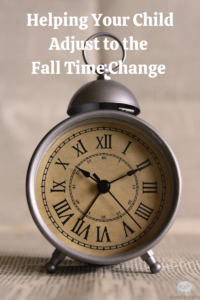It’s that time of year when it gets darker earlier and is often still dark when we wake up. On November 3, 2024, at 2 a.m., our clocks will fall back to Standard Time, gifting us an extra hour of glorious sleep. While the prospect of an additional hour may be welcome news (I know I’m excited!), the shift can cause anxiety for households with young children.
Here are some tips to help your family smoothly transition to the fall time change:
Reset Their Systems: Exposure to sunlight in the morning helps reset their circadian rhythms for the day.
Stick to Your Routine: Children thrive when they know what to expect. Keeping the same sequence of events helps them feel secure through the shift.
Be Flexible: The time change can be tough for everyone. Allowing children to nap or go to bed a little earlier (even if you’re trying to extend their wake times) can make a significant difference in their adjustment.
Stay Consistent: Consistency is your BEST friend when it comes to sleep—and parenting in general! Maintaining a consistent response and routine is key.
Beyond these tips, consider your child’s temperament. For some, the time change is no big deal. But for children who are more sensitive, we need to be extra patient and allow flexibility in their adjustment.
Do-Nothing Approach
For easygoing children, simply shifting their schedules to the new time with minimal or no adjustments may be just fine.
Gradually Adjust the Time
For more sensitive children, gradually shifting their schedule a week before can be very helpful. Move naps and bedtime 15 minutes later each day. In four days, their schedule should align with the “new” time.
Example: If your baby naps at 9:00 a.m. and 1:00 p.m. and goes to bed around 6:30 p.m., begin adjusting the schedule on Wednesday. Put them down at 9:15 a.m. and 1:15 p.m. and shift bedtime to 6:45 p.m., making 15-minute adjustments daily. This gradual change can ease their transition.
Adjust After the Fact
If you miss the chance to gradually shift before the time change, don’t worry. Adjust their schedule afterward, and observe where they struggle to offer more targeted support.
Remember: The time shift can throw everyone off, so give your family some grace during this transition. It’s normal to see a few mornings with early wakings or some sleep regressions. Consistency, patience, and following these tips can help prevent major disruptions.
Additional Tips for the Time Change Transition
As you adjust routines, it’s also a great time to check your child’s sleep environment:
– Lighting: Although it’s getting darker earlier, make sure there aren’t any lights shining into your child’s room. Blue, green, purple, and pink lights can disrupt sleep by interfering with melatonin production. Red or amber lights are ideal for preserving sleep quality.
– Temperature: A cool room is best for sleep. While some families prefer between 65 and 69°F, adjust according to your child’s comfort. As temperatures drop, make sure your child’s room is comfortably cool but not too cold or hot.
– Sleepwear: Ensure your child’s attire suits the season. If using a sleep sack or swaddle, consider the material and weight. For example, if your home is warmer, avoid heavy fleece pajamas under a wool sleep sack, as this can be too warm. A lighter cotton pajama with a fleece sleep sack can provide balance. For children who tend to run warm, try a light T-shirt with short pajama bottoms and socks, which keeps feet warm while allowing cooling.
With these extra steps, you can help ensure an optimal sleep setup. If you’re using ambient noise like a sound machine, pair it with a dim, red, or amber night light to avoid disrupting your child’s sleep rhythms. Finally, set the thermostat to a seasonally appropriate level, and make sure your child’s clothing keeps them comfortable through the winter.
Ready to make this time change smoother for your family? Start implementing these tips today, and let us know in the comments which strategy works best for you! For more sleep tips and personalized support, check out our services.


Leave a Reply